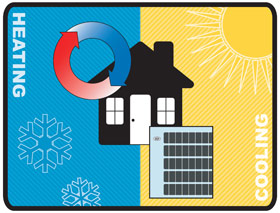165
References:
Hsu, P., Song, A., Catrysse, P., Liu, C., Peng, Y., Xie, J., Fan, S., & Cui, Y. (2016). Radiative human body cooling by nanoporous polyethylene textile Science, 353 (6303), 1019-1023 DOI: 10.1126/science.aaf5471
 |
| Different parts of the world spend energies through the year, either cooling or heating up their homes |
While a good part of the Western hemisphere spends tons of gas in heating their homes, the Eastern hemisphere is quickly becoming a major consumer of electricity for purposes of cooling their homes and offices. As temperatures soared over the last summer often crossing the 40oC mark in India, millions of Indians turned to their air conditioners remotes to cool themselves and their surroundings. But can developing economies with polluted atmospheres continue to burn coal and other fossil fuels to keep themselves cool? The natural alternate would be use solar or tidal sources of energies or simply rethink our designs and try to cool the individual rather than his surrounding. This is the line of thinking that the Department of Material Sciences and Engineering followed at the University of Stanford under the aegis of Prof. Yi Cui.
Perspiration is our body’s natural mechanism to cool itself. When temperatures soar, the body starts perspiring to maintain its temperature around the normal mark of 37oC. The clothes we wear allow the perspiration to escape through them further helping us cool the body. But our body also emits heat in the form of infrared energy which clothes trap. While this trapping is usually welcome when using blankets or sweaters in winter to keep us warm, the trapping of heat becomes problematic in summer, because it does not cool the body enough.
 |
| Perspiration is body’s way to keep you cool |
But the team at Stanford has managed to synthesize material that allows the infrared heat to escape as well and thereby allowing the body to cool better than if they were wearing cotton clothing, something that we have known works best in summer. Ideally, the best thing to wear to dissipate all infrared heat would be wearing nothing, but since that is not possible in an everyday scenario, the new material is something that could offer users respite from the heat.
In a usual new findings story about Science, the biggest hurdle in its further development is the cost of manufacturing it. Research labs usually have funding grant money and a variety of instruments and chemicals such as carbon nanotubes that allow them to make tiny amounts of test material for their own consumption. But manufacturing for the masses is a different ball game altogether. The process of transfer of technology usually takes a decade or two. However, in this case, one can expect the process to go through quicker, because the starting material is not uncommon. It is so regularly used that it is actually a pain to manage it. It is polyethylene or commonly known plastic used in bags.
The primary reason why polyethylene was chosen is because its allows infrared heat to escape through it. Since polyethylene is also transparent, the researchers needed to first make it opaque to normal visible light. Luckily, a variant of polyethylene used in the battery industry is opaque and was used by the researchers at Stanford. Polyethylene, however, does not let water vapour escape. By treating it serially with chemicals, the researchers were able to make it permeable to water. Since this kind of polyethylene is already being made for the battery industry at a large scale, it would not be very difficult to introduce it at a mass level. Rather, polyethylene makers would simply be called textile makers in the future, if the technology picks up.
As per lab test, the team at Stanford was able to cool surface temperature by 2.7 oC using fabric that incorporated the modified polyethylene. Further advances in the technology would actually help us cool individuals in the room rather than the room itself, making summers with out air-conditioners a possibility in the future.
References:
Hsu, P., Song, A., Catrysse, P., Liu, C., Peng, Y., Xie, J., Fan, S., & Cui, Y. (2016). Radiative human body cooling by nanoporous polyethylene textile Science, 353 (6303), 1019-1023 DOI: 10.1126/science.aaf5471

